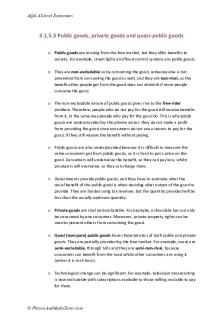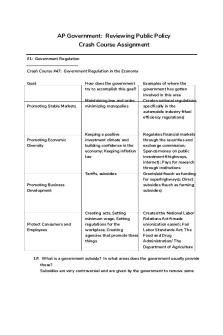Chap 5 Externalities, environmental policy, and public goods PDF

| Title | Chap 5 Externalities, environmental policy, and public goods |
|---|---|
| Course | Introduction to Microeconomics |
| Institution | University of Delaware |
| Pages | 2 |
| File Size | 54.4 KB |
| File Type | |
| Total Downloads | 26 |
| Total Views | 129 |
Summary
Econ 101 Chapters...
Description
Chap 5- Externalities, environmental policy, and public goods Unintended Consequences ● No one sets out to create pollution- pollution is an unintended byproduct of various activities. Pollution wouldn’t be a problem if it only affected the person who created it; people would create pollution up until the MC of polluting was equal to the MB ● Pollution is an example of an externality ● An externality is a benefit or a cost that affects someone who is not directly involved in a market transaction (production or consumption) ● In other words, an externality is an unintended consequence (side effect) of a market transaction ● A negative externality is an adverse/detrimental side effect (cost endured by a third party) ● A positive externality is a beneficial side effect (benefit experienced by a third party) ● Private cost is the cost borne by the producer of the good ● External cost is the cost borne by a third party (neither producer nor consumer) ● Social cost is the total cost of producing a good or service including private and any external cost ● Private benefit is the benefit received by the consumer of a good ● External benefit is the benefit received by a third party (neither producer nor consumer) ● Social benefit is the total benefit of consuming a good or a service including private and an external benefit Alternative Government Regulation ● The traditional approach to combat pollution is command-and-control- set uniform emission (technology) standard ● EX: Command all pollution sources to meet identical emissions level ● Control compliance ● EX: Requiring car manufacturers to install abatement technology (catalytic converters) Command and Control is not productively efficient Different pollutes likely have different compliance costs EX: Once car manufacturer might be able to reduce pollution more cheaply than its competitors Cap and Trade ● Allowing firms to trade emission permits achieves emissions reduction at lowest cost ● A transferable emission permit system requires polluters to possess a permit for each unit of pollution it emits ● Regulators issues number of permits equal to the emission goal (cap) ● Regulator allows polluters to exchange permits (trade) ● Incentivizes productive efficiency w.r.t (with respect to) pollution abatement ● Rivalry- A good is rival when one person’s consumption means no one else can consume it ● Excludability- A good is excludable if those who don’t pay for it cannot consume it
● ● ● ● ●
Demand for a Public Good Consider a small frontierstown in the west with 2 frontiersmen (Davy and Daniel) Both own land that is located close to a forest which is wildfire-prone Both value wildfire prevention activities (removal of fire fuel such as underbrush) Each acre cleared reduces wildfire risk of both properties...
Similar Free PDFs

Public Goods and Common Resources
- 18 Pages

Interest Groups and public policy
- 10 Pages

Public Policy Essay
- 3 Pages

Public Policy Analysis paper
- 15 Pages

Public Policy Assignment
- 4 Pages

Public Policy - Elarba Badih
- 3 Pages

Reading Article - Public Policy
- 2 Pages
Popular Institutions
- Tinajero National High School - Annex
- Politeknik Caltex Riau
- Yokohama City University
- SGT University
- University of Al-Qadisiyah
- Divine Word College of Vigan
- Techniek College Rotterdam
- Universidade de Santiago
- Universiti Teknologi MARA Cawangan Johor Kampus Pasir Gudang
- Poltekkes Kemenkes Yogyakarta
- Baguio City National High School
- Colegio san marcos
- preparatoria uno
- Centro de Bachillerato Tecnológico Industrial y de Servicios No. 107
- Dalian Maritime University
- Quang Trung Secondary School
- Colegio Tecnológico en Informática
- Corporación Regional de Educación Superior
- Grupo CEDVA
- Dar Al Uloom University
- Centro de Estudios Preuniversitarios de la Universidad Nacional de Ingeniería
- 上智大学
- Aakash International School, Nuna Majara
- San Felipe Neri Catholic School
- Kang Chiao International School - New Taipei City
- Misamis Occidental National High School
- Institución Educativa Escuela Normal Juan Ladrilleros
- Kolehiyo ng Pantukan
- Batanes State College
- Instituto Continental
- Sekolah Menengah Kejuruan Kesehatan Kaltara (Tarakan)
- Colegio de La Inmaculada Concepcion - Cebu








